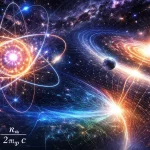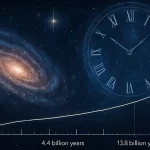Written by Dr Kiril Chukanov, June 2009, Calgary, Canada
Copyright© 2009 by Dr Kiril Chukanov
The living Observer (the whole of animate substance in the universe – which exists only on earth, see GQM-I, II, III, IV) “calibrates” nature with the help of his own standards. The evolution of the living Observer goes through qualitatively different quantum life periods. Their time period is governed by natural symmetries. The transition from one period to another or from one quanta time to the next one following it in the chain of times is accompanied by the increasing complexity of the Observer’s features which undergo qualitative changes. New kinds of plants and animal species make their appearance. The organization of the universe of animate substance (Life) is governed mainly by the basic proportionality coefficient K2,e,p = 12.37 and its derivates:
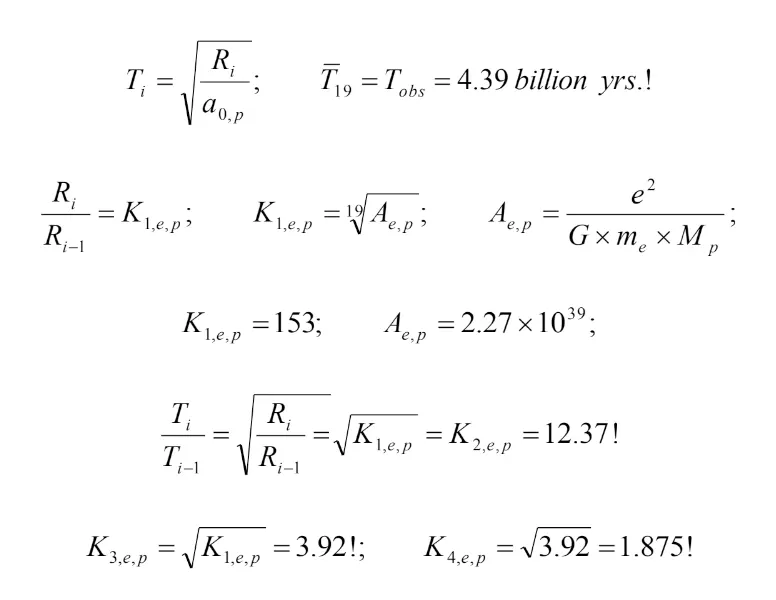
The quantum transformation of times in the chain of life evolution is also governed by the same proportionality coefficients. In order to build the life evolution chain besides the quantum proportionality coefficients, we have to know some reference points in this chain. Such reference points are some very important moments in the life evolution: some milestone events. The milestone events are located in the main quantum knots (maximums on the diagram of the Quantum Wave of Life Evolution). On the diagram of life evolution “I” means the intensity of manifestation of the main properties of the corresponding quantum animate object (number of sub-quantum species, amount of individual taxonomic units, stability, activity,…etc). The first derivative I = dI/dT is manifestation of the speed of the evolution of life. “Т” is the time elapsed of evolution. The catastrophe moments (minimums on the curve “I” are located somewhere between two neighbor maximums (the moments of flowering). The values of these minimums (catastrophes) cannot be calculated precisely because they are not quantum knots on the diagram of life evolution. Their values are blurred; the minimums could be, with different probability, located at any point on the curve of evolution between two neighbor maximums. Formally they can be determined (with highest probability) as a medium between two maximums (however this estimation can be wrong in many cases).
Time started some 4.39 billion years ago. After the beginning of the Cycle of the Universe the earth was inhabited by primitive unicellular organisms (See Figure 1). Traces of prokaryote bacteria and blue-green seaweed were found in Greenland dating from 3.85 billion years ago, in Australia dating from 3.66 billion years ago, in South Africa, and other places on earth. About 2.1 billion years ago – the First Great Catastrophe – the first major mass extinction occurred. A considerable part of the prokaryotes and unicellular blue-green seaweed were replaced by the eukaryotes. These are the modern living cells; almost all living organisms of today are built of the eukaryote cells with exception of some bacteria and blue-green seaweed (relicts from the Undetermined Beginning of the world. The eukaryotes have chromosomes situated in a well-shaped nucleus, mitochondria, and chloroplasts. They contain membrane-bound organelles (fringe, for example) facilitating their motion. Eukaryotes have higher chances for quick evolution. The greatest quantities of these fossils were found in the layers of rock 1.25 billion years ago (the First Flowering – maximum on the diagram). About this time sexual reproduction evolves, increasing the rate of evolution; simple multi-cellular organisms evolve, mostly consisting of cells colonies of limited complexity.

A global glaciation (at the time of the Second Catastrophe – 0.85-0.95 billion years ago) reduced considerably diversity of life. Here unicellular organisms were replaced by multi-cellular invertebrate organisms. Multi-cellular invertebrate organisms are more progressive: the round worm (Spriggina), different kinds of jelly-fish, some kinds of corals, pseudo mollusks, etc. The second flowering (the maximum on the diagram) of the Ist Period of Life occurred about 700 million years ago. Paleontological investigations show that at periods of several millions of years, a great variety of animals and seaweeds exploded in the world’s oceans; seaweeds, artopodes, brachiopods, fungi, corals, sea anemones, worms, starfish, trilobites, etc. From the point of view of modern science, it is very difficult to offer an explanation about this explosion of life. Some scientists believe that the explosion of life 700 million years ago is only ostensible and that there had been a great variety of invertebrate species during Pre-Cambrian but that they left no traces. Later, they say, the chemical conditions in the Cambrian seas were much more favorable for the formation of solid skeletons and shells, which were consequently much better preserved. Geologists say that the increased oxygen content in the air (a result of the photosynthesis of the first animate organisms) led to the appearance of many new species.
The Third Catastrophe (around 540 million years ago) is connected with next Ice age. The true reasons, however, lie in the realization of the world global symmetries throughout quantum life evolution. Though with reduced number of species and specimen, representatives of the First Period of Life will persist until the end of the present cycle of the universe. Some of the “relict” species undergo some limited evolution, but they preserve their specificity. They are “atoms” of the First Period of Life!
The Third Catastrophe is the beginning of the Phanerozoic Eon – literally the “period of well-displayed life”. It marks the appearance in the fossil record of abundant, shell-forming and/or trace-making organisms. It is subdivided into three eras, the Paleozoic, Mesozoic and Cenozoic, which are divided by major mass extinctions.
The first known footprints on land date to 530 million years ago, indicating that early animal explorations may have predated the development of terrestrial plants.
The beginning of the Transition Period (after the Third Catastrophe) is indeed worth noticing. Plants and animals moved to land in large numbers. The first primitive plants move onto land, having evolved from green algae living along edges of lakes. They are accompanied by fungi, which may have aided the colonization of land through symbiosis. The first amphibians appeared: Ichtyostegea, almost a meter long; some kinds of fish could breathe on dry land; the first insects and spiders appeared. The tropical climate produced vast woods dominated by scaly trees, tree ferns, and first conifers, the land fauna was enriched by many new species, while aquatic fauna lost its dominant role in terms of species number.
At the time of the First flowering of the Second Period of Life (about 360 million years ago) the earth begins to be recognizable. See Figure 2. Insects roamed the land and would soon take to the skies; sharks swam the oceans as top predators, and vegetation covered the land, with seed-bearing plants and forests soon to flourish. Four-limbed tetrapods gradually gain adaptations which will help them occupy a terrestrial life-habit.

The zone of the maximum (few hundreds millions of years: before and after the moment of the maximum) was zone of flourishing, stability, diversity. Then a brisk downfall occurred. About 230-250 million years ago occurred the First Catastrophe of the Second Period of Life.
The so-called “Permian-Triassic” mass-extinction eliminated over 95% of species. Gone were the trilobites, the corals, with developed nerve, digestive, and muscular systems (bryozairs), and the brachiopods. Only two hundreds species out of approximately 30,000 survived. This “cleaning of the slate” may have led to an ensuing diversification.
Around the First Catastrophe the first reptiles appeared. Traces were found – at the beginning of the first sub-period (230-65 million years) – of labyrinthodons (animals with fang-like teeth) and dimetrodons, characterized by a spinal ridge in the form of a fan. That was the age of the techodons (small reptiles) which moved with the help of their back limbs.
What explanations do scientists offer about the reasons for the First Catastrophe of the Second Period of Life? Explanations include the fall of meteors that poisoned the air, water, land; intensive bombardment by cosmic rays that were selectively fatal resulting from a supernova near our solar system; reduction of the mean temperature after intense volcanic activity; progressive disruption in the food chain as one sensitive species disappeared, to be followed by the geometrically progressive extinction of species that were dependent on it; etc. The most probable hypothesis of the mass extinction is considered the hypothesis offered by Fred Wagner – the Pangaea Theory. According to F. Wagner, 230 million years ago as a result of movement among the tectonic platforms around the planet, the land masses drifted together, creating a single giant continent Pangaea (Greek for all + earth). The most favorable environment for aquatic species like corals, amphibians and fish is the shallow coastal zones.
As a result of Pangaea’s formation, the amount of this environment was severely reduced, causing the outright extinction of numerous species with the subsequent elimination of species dependent on them. Climatic changes developed as a result of quartering the planet into a single huge land mass and an equally huge ocean; they became severe, interrupting many food chains. Many paleontologists accept the Pangaea Theory but have mistaken cause for effect. The ultimate cause for the global mass extinction of life was the realization of world symmetries, no matter what the mechanism of nature happened to be. Another natural mechanism of the Great Effacement of Life could be the Great Ice Age during the early Permian period which began 275 million years ago.
The first sub-period (230-65 million years) is characterized by the reign of the biggest animals in the history of the earth – the dinosaurs. Their earliest representatives are found in the layers dating back as far as 203 million years ago. One of them, the diplodont, inhabited what is now America, during the Cretaceous Period and was twenty-five meters long. Some of dinosaurs were like tanks. Ankylosaurs, for example, were covered by an impenetrable armor, protecting them from the fangs and horns of their enemies. The dinosaurs-predators were real giant too: the tyrannosaurs (15 meters long); the Ichthyosaurs (about 10 meters long); the Erchyosaurs (about 6 meters), etc. The flying lizards also appeared at that period. The largest were the Pteranodons, whose wingspread was 8 meters.
The dinosaurs flourished 100 million years ago (at the maximum of the diagram of Life Evolution); the majority of fossilized skeletons and species date back from this time. In compliance with the world symmetries the dinosaurs disappeared from the face of earth about 65 million years ago (at the moment of second catastrophe). This catastrophe (known as Cretaceous-Tertiary Extinction) eradicated half of animal species except the ancestors of modern birds. Within several million years, all dinosaurs, flying lizards, gigantic aquatic reptiles, and one-fourth of sea invertebrates, which had survived the first catastrophe, disappeared.
The hypotheses concerning this catastrophe are even more numerous and exotic. The mysterious gigantic catastrophe stirs the imagination of scientists to such a degree that even those who have nothing to do with paleontology feel obliged to present their ideas about these scientific issues. Among those hypotheses the best accepted is the hypothesis of American physicist Luis Alvares and his son Walter Alvares. They suggest that the fall of an enormous asteroid containing a high percentage of iridium caused formation of dust shield around the earth that prevented the sunlight to reach the plants. As a result the photosynthesis of plants was disrupted and animals lost significant part of their food. The dinosaurs, they hypothesize, were especially sensitive.
Toward the end of their reign, the dinosaurs handed the torch of evolution to the more progressive animals – the mammals. The manifestation of property intensity “I” of reptiles (number of species and number of individual) was growing smaller with the approach of the End of the World but it would never become zero. They became fewer in number and degenerate, losing their significance, but they continued to exist. Today, even though rather miserable in comparison to their predecessors, their representatives are the crocodiles and lizards. There might also be some small populations of dinosaurs today in a changed or degenerated form. Are not the legends of the dragons in Congo rain forests and the Loch Ness monster some authentic stories handed down from people who saw the last dinosaurs on the earth? Moreover, it is known that in some isolated tropical regions, representatives of fern trees are still found; they are contemporaries of the dinosaurs, sharing their destiny.
The dinosaurs left the earth to be inhabited by mammals. At the beginning these were small mammals: insect-eaters, rodents, saccade animals. Later the mammals developed into two main groups: the forerunners of the ungulates, or hoofed herbivores (candylathres) and the forerunners of the predators (creodonts). The mammals began their period of flourishing 54 million years ago; hundreds of species have come into and passed out of being. Among the extinct are many different species of rodents, insect-eaters, ungulate mammals, and proboscis mammals. In the floral world, gymnosperms gave space to the angiospermous plants.
The transition period (approx 40 – 15 million years) was the period of primates. They handed the torch in the Observer’s evolution. The long-soled primates are small predatory mammals, living in the trees. About 12-15 million years ago the earth climate became even more severe (much colder). This time coincides quit normally with the first catastrophe of the Third Period of Life which swept away more than 75% of the species of mammals. The discussions about this catastrophe are still going on in the scientific circles. The climate is once again presented as the greatest perpetrator of the catastrophe. Others say that the humanoids set out on mass destruction of the big mammals. Yet the true reason is quite different.

The quick disappearance of forests made the greatest part of the driopithecus climb down in order to survive. They underwent an evolution on the land and became humanoids (as believed by scientists). The main representatives of the humanoids at the beginning of the first sub-period (15-12 million years – to about 6 million years) were the Rhamapithecus. Their traces date back as far as 14 million years ago. It is assumed that they walked erectly and used primitive tools. A later form of Humanoids is the Australopithecus (second sub-period); its oldest traces were found in Kenya, dating back as far as 7 million years ago. The Australopithecus walked upright and the measurement of the skull (V = 576 cm3) was bigger than that of the gorilla (V = 497 cm3), which had the biggest skull measurement among apes. They made use of primitive tools and fire. See Figure 3.
Rhamapithecus disappeared at the time of the third catastrophe (about 3 million years ago) in the stomachs (as believed) of Homo Habillis who appeared during that time. There was a great difference between the Australopithecus and Homo Habillis mostly because, for the first time in the history of human life, an animate being made its own tools. This is a characteristic of a conscious human being. The skull measurement of Homo Habillis is 800 cm3. Homo Erectus appeared in the second half of the transition period: about 1.7 million years ago. Homo Habillis already had many human features. Both Homo Habillis and Homo Erectus shared the destiny of their predecessor; at the time of the first (great) catastrophe of the Fourth Life Period they disappeared in the stomach of a new hunter – the Pithecanthropus. The Sinanthropus appeared a bit later – in the second sub-period. The most numerous traces of Pithecanthropus are found in sedimentary layers 650 thousand years old, the flowering of its evolution.
An important phenomenon was the appearance of spoken language – a powerful tool on the road of progress. The Pithecanthropus and Sinanthropus started exchanging information with those of their kind using sound signals. The Archanthropuses disappeared somewhat suddenly at the time of the third catastrophe (about 260 thousand years ago). It seems that their successor in the evolution process brought about their total destruction. There were found traces indicating that the Archanthropuses were cannibals. See Figure 4.
The oldest traces of Neanderthals have been found in France near town of Nice. There, 280 thousand years ago, they build their homes. Their skull is much bigger in measurement (V = 1200-1600 cm3). There is one problem related to the Neanderthals which is still unsolved. If the skulls of the early Neanderthals (170 thousand years ago – their flowering) are examined carefully, one would see with amazement that they are closer to ours and less to that of the late Neanderthals (60-70 thousand years ago). The brain of the late Neanderthals had undeveloped bill-like front parts, a sigh of degeneration. They were gradually losing their social features; their communities grew unstable. The Neanderthal was “doomed” to leave the stage of life at the time-span of the first great catastrophe of the Fifth Life Period. The executor of the verdict could have been the next one in the evolution – the Cro-Magnon Man, as it had happened with Neanderthal’s predecessors. The Cro-Magnon Man, however, was a reasonable man (Homo Sapiens) and he could not have allowed himself to eat his direct predecessors, the Neanderthals). Nature resorted to another execution, the degeneration and self-destruction of the late Neanderthal. Alas, the same could happen with us – the last human generations on earth!
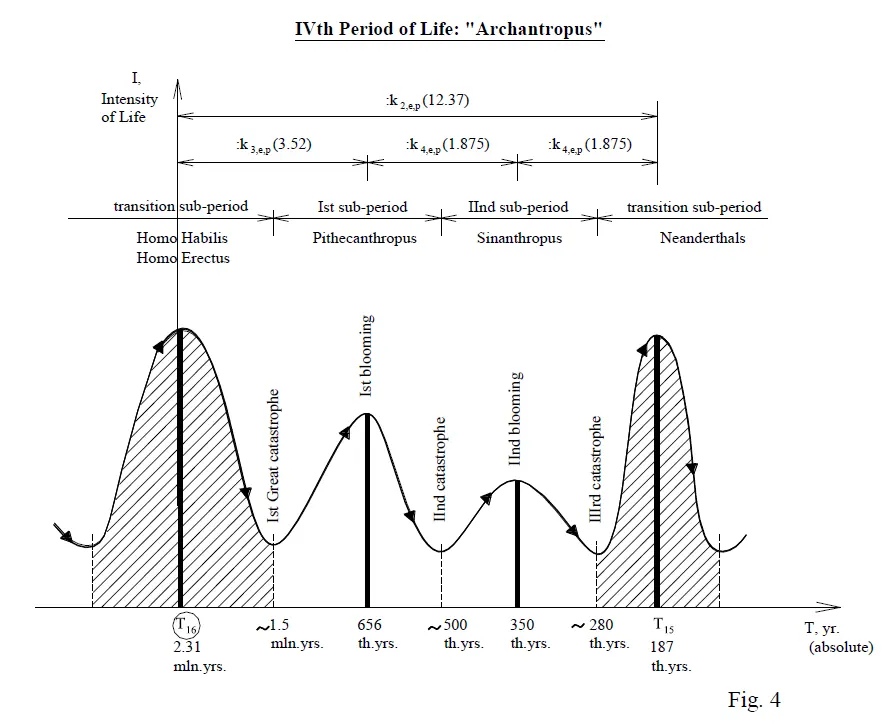
The appearance of Homo Sapiens occurred sometimes in the first great catastrophe of the Fifth Life Period. Its representative was the Cro-Magnon Man (also called the Shancellad or Grimaldy Man) who is predecessor of all human races nowadays. This is the period in which the biological evolution was replaced by the social evolution. See Figure 5. The Pre-Historical Man is the transition link to the Historical (Civilized) Man. The first religious beliefs date from this transition period, supported by the fact that 20 thousand years ago man started to bury his dead relatives. The first forms of art were born. In 1908 archaeologists discovered in Chernigovska region (Russia) the remains of a stone-age village, the bones of a mammoth, and other bones, later discovered to be fragments of musical instruments. The first cave drawings also date from that transition period.
The Cro-Magnon Man, unlike his predecessors, disappeared in a social way and not in biological way. He gave away his position in the evolution of life to the Pre-Historical Man 20 thousand years ago – at the time of the third catastrophe. The time of his flowering happened in the quantum knot (maximum) on the diagram of life evolution – about 14 thousand years ago. The first traces of farming and animal breeding were found in the layers 12 thousand years old.
From what I have stated so far, it becomes clear that evolution of life is not governed by the forces for blind chance – Darwin’s natural selection, for example. The evolution of animate nature is governed by a strictly determined program reflecting world harmony. It is absolutely wrong to believe that external factors such as changes in environment determine the direction of evolution. The coincidence between the climate on earth, the structural changes on the earth surface (formation and separation of the continents, volcanic and tectonic activities), the sun’s activity, and quantum knots (moments) on the diagram of the Wave of Life Evolution stress only one thing: the evolution of the animate matter (being) and changes in the environment which it inhabits are governed by one and the same program, reflecting the world symmetries.
What appears to be the true creator of social animate life is not the blind chaos of natural selection but the Observer’s purposeful evolution, the gradual quantum concentration of its Soul-Energizer. The time in the course of which the Observer exists and develops itself is not simply a chain of consecutive stages independent from one another, but a dialectical unity of different quantum life periods which are images of the unique period – that of the Observer. Any given quantum time (from 10-23 s to Tun, p = 4.39 billion years) contains any other quantum time; in that way, it determines the later and is determined by it. In a closed world as this one, where past, present, and future events are in mutual correlation, there is not an initiating cause for the creation and existence of the world which would in the long run turn out to be its destruction. It is a self-determining world; it has no need of proto-substance. Past objective in the future, future objective in the past – is this not an infinite swirl of life, one infinite repetition of the evolution of animate substance? Here comes to light one of the Primary Substance’s principle features: the infinite and transient dialectical unity. A model such as this one is found in the Hindu religious where the existence of the world is interpreted as one constant repetition of the same cycles. Brahma destroys and recreates the world every 8.5 billion years.
The Sixth Period of Life is the period of Historical (Civilized) Man. See Figure 5. The Civilized Man is the “elementary particle” of Social Human Life. The time-interval which the Human Civilization has at its disposal is a very short one – some 6-8 thousand years. The hypothesis that our civilization is in its early childhood and that we have million – billion years of development and spreading across the universe are vain hopes and fantasies.
Before trying to pin down the milestones on the curve of Evolution of Human Civilization, there are questions which demand an answer. What is human civilization? How it differs from other periods of life? What is the essence of Human Civilization?
Archeological excavations have discovered considerable progress at the end of the Paleolithic Period, when Home Sapiens began his reign. The Mesolithic age witnessed the appearance of cattle breeding and farming; the Neolithic is the age of the first devices of polished stone, weaving and pottery. Yet even the most developed Neolithic communities inhabiting North Africa, the Near East, and the Middle East did not reach the level of one civilization. In the period circa VIIth – VIth millennium B.C., some relatively rich settlements, frequently surrounded by thick walls which indicated that they had something precious to protect, sprung up in Asia Minor, Syria, and Palestine. Yet these settlements were rare exceptions while some of the oldest cultures (Hierehenon in Palestine and Chatal Huuk in Asia Minor) did not develop as civilizations. Therefore the beginning of Human Civilization should have occurred later. Anyway, these first walled settlements can be considered as the oldest outposts of the Human Civilization.

It is natural to assume that the beginning of Human Civilization was related to some kind of qualitative jump (revolution) in the field of labor and culture. Most likely the moment of the reclamation of the fertile land along the three great rivers in Africa and Asia (Nile, Euphrates, and the Indus) by cattle breeders and tillers was the beginning of Human Civilization. This qualitative jump is also linked with the construction of an irrigation system which led to a rapid increase in labor productivity. Indeed, productivity and corresponding economic relations are at the very basis of the qualitative differences between the different periods of Human Civilization. These relations are social, a qualitatively new form of Primary Substance – Common Social Consciousness (Soul Energizer, see GQM-III, Chapter I) of the Human Kind. All six elements of the Common Human Social Consciousness (political, juridical, moral, esthetical, religion, and science) are subjected to the economic relations of production and consumption.
The first traces of an irrigation system found date back as far as the end of the Fifth millennium B.C. This time coincides with the time-interval of the first great catastrophe of Sixth Period of Life. The increased labor productivity led to a decrease of the number of people involved in the production of food and the appearance of craftsmen: weavers, potters, shoemakers, ship-builders, etc. Society was differentiating, and the class of exploiters appeared. The qualitative changes in the manner of production affected the spiritual life of people. The religious temples became the center of spiritual life. These were rich economies and their management and trade required a writing system. Cuneiform writing appeared circa 3500 B.C. in Sumeria (Mesopotamia).
Still scientists are not clear as to which is the first compact civilization in the world: was it the Egyptian civilization or the Mesopotamian? The priority, however, is usually given to the one that inhabited the lands along Nile. Archeological excavations show that the natives led sedate lives already in the VI th millennium B.C. They raised cattle and farmed but were still afraid of subjecting the great river to their needs. It seems that at the beginning of the IV th millennium B.C., the population of Egypt constructed the first irrigation systems and received a tenfold increase in their crops. See Figure 6.Towards the middle of the IV th millennium B.C., the merging of the two states, the Upper and Lower Egypt, took place.
Proceeding from the information offered above, one could draw the following conclusion: the beginning of Human Civilization (Ancient Civilization) occurred circa 4000 B.C. (dI/dT = 0).
Each socioeconomic human formation is born within the range of the one preceding it, and then within its own boundaries it flourishes and fulfills its historical mission; after accomplishing its mission it becomes of no importance for the following historical evolution but continues to exist at a reduced intensity to the end of the world cycle.
The socioeconomic order (system) of Pre-Civilization existed within the boundaries of the transition period (20 th – 8 th millennium B.C.). The appearance of this socioeconomic order was connected with the appearance of articulate speech, which united people and transformed the human tribe into human society.
The evolution of each socioeconomic order is governed by the Law of Trimodular Transformation of Intensity of Properties. That means that every Life Period is divided in three quantum sub-periods, one of them is sub-period of transition to the next Life Period.
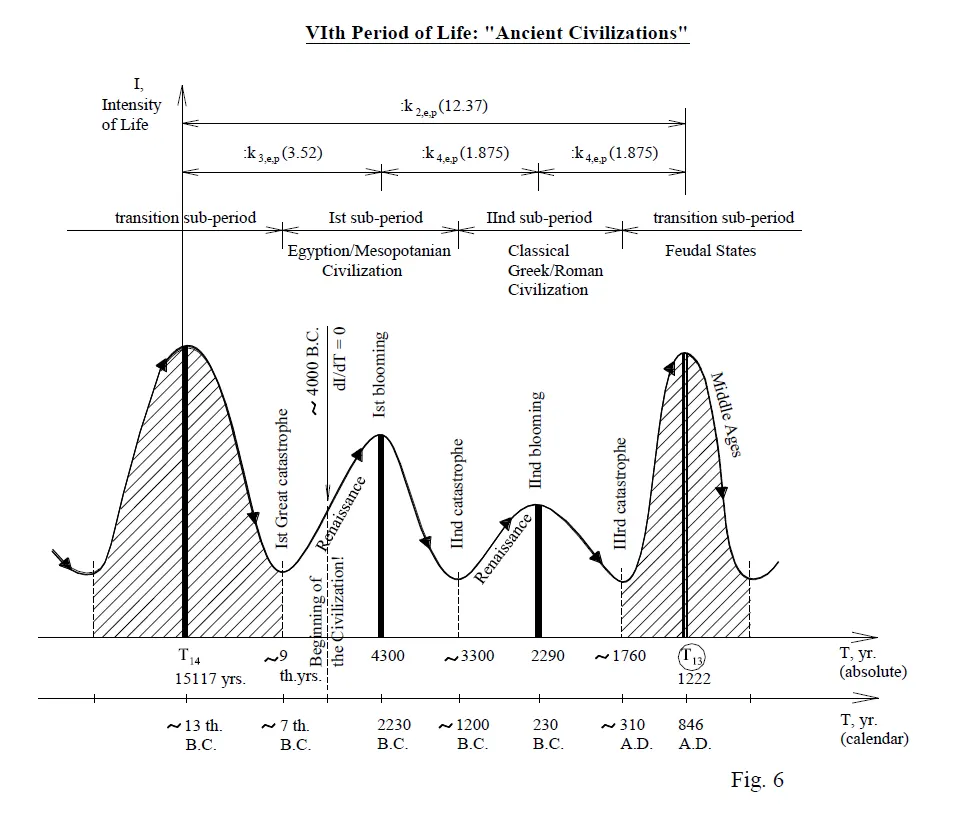
The main features determining the momentary state of evolution of the Class “Civilized Human Being” are manifested in the collective ethics and morals of historical classes and historical social orders (systems), including their culture, art, religion, tools and methods of harnessing of the environment for practical use, weapons, energy sources, etc. We call all these features “intensity of life – I”. Individual human beings are only executors of the world symmetries. Even though free in their personal acts, in general, they are obliged to satisfy the requirements of the world symmetries (the quantum wave of life evolution, for example): the common and necessary are realized through the specific and arbitrary. The “technical means” used by the Unique Observer are the passions, needs, wishes, and personal interests of the individuals. Every social class or social order has its periods of progress and flowering when its concepts fit the momentary state of evolution of the Observer. These are the happiest and more efficient moments in history – periods of relative stability and victories. But the Observer develops and improves his features and performances in Time while concepts of the social classes and social orders are no longer in resonance with the current concept of the Observer (on the quantum wave of life evolution). The social class/order loses its stimulus for active life; it has reached its highest objectives, and its interest in life is abolished. A social class/social order such as this vegetates for some time, gradually degenerates, and enters into conflict with the next (in the evolution) social class/order that has already become an embodiment of the Observer’s progressive concept; then the former social class/order is destroyed and replaced by the latter social class/order. The decline of a social class/social order is demonstrated in its inability to actively control politics and the economy, corruption reaches enormous proportions, and its culture and morals are no longer positive.
During the transition sub-period (from 20 thousand to 9 thousand years ago), the Pre-Civilized Man was still a gatherer of natural food (plants and seeds) and a hunter. Around the time of the first great catastrophe of the Fifth Life Period (9 thousand years ago) appeared farming and cattle breeding.
The first sub-period of the Fifth Life Period (9 – 3.3 thousand years ago) is the time when first walled towns began to appear in Mesopotamia. They were constructed with a temple in their center. The existence of farming and the domestication of cattle, the discovery of iron and copper around 6000 B.C., and artificial irrigation provided the facilities for the production of extra provisions, and it, in turn, led to the appearance of the first “ancient civilizations”: Egyptian and Mesopotamian. At the maximum of the first sub-period (approx 4000 B.C.), writing system (hieroglyphics) and paper (3860 B.C.) were invented. The great pyramids in Giza were built (3000 B.C. – 2500 B.C.). Sumerians, and later Egyptians, started to develop mathematics, astronomy, economics, medicine, law, and politics.
The first sub-period (7000 B.C. – to about 1100 B.C.) was the era of the first slave-holding states, the boundaries of which were established on the basis of economy-political needs of the region (Egypt, Lower Mesopotamia, The Hittite state, Mycenae, Middle Assyria, Achaean state, etc.). This sub-period finished at the time of the second catastrophe when many old civilizations such as the Old Kingdom in Egypt, the first Minoan, and first Indian civilizations disappeared. Whole nations disappeared totally from the face of the earth.
After the first flourishing of science, there was a long period of intellectual hibernation.
The second sub-period is mainly connected with ancient Greek city-states (Athens, Sparta, etc.) which flourished around the third century B.C.; Roman empire; the Carthaginian North-African empire (8 th – 2 th century B.C.), Assyria, Persia (which flourished under Cyrus the Great, 590-529 B.C., and Darius, 521 -486 B.C.), China under the Chou dynasty, and India. The flowering of the second sub-period is mostly marked by the rise to power of Alexander the Great (333 B.C.) who created the largest known empire in human civilization to that point.
The long period of hibernation (in science) was followed by a scientific awakening in Greece after the second catastrophe (approx 1100 B.C.). The climb up on the curve of Life Evolution is accompanied by an increasing of the Intensity of features or increasing of the progress in the evolution of the dominating (in this period) class “alive being”. The first great scientists of this Renaissance were Thales and Anaximander of Miletus (an Ionian town), 600-550 B.C. Ancient Greece produced many great scientists as Pythagoras (mathematics, 582-507 B.C.), Anaxagoras (experimentalist and astronomer, 500-428 B.C.), Empedocles (philosopher, 495-435 B.C.), Hippocrates (physician, 460-377 B.C.), Democritus (philosopher, 460-370 B.C.), Diogenes (philosopher, 412-323 B.C.), Plato (philosopher, 427-347 B.C.), Aristotle (philosopher, 384-322 B.C.), Euclid (mathematician, 300 B.C.), Archimedes (inventor, 287-212 B.C.), and many others. The decline of Greek science started after the second flowering of the period, around 260 B.C., which is indicated by the relatively absence of important scientists after this time.
During the ascent on the curve of civilized human evolution, science became a universal phenomenon, flourishing on different continents without significant exchange of information between them.
The Macedonian Empire under Alexander the Great differed from traditional slave-holding states in that it encompassed territories with diverse economies, geographies, cultures, and ethnic populations. In the latter part of this sub-period, the Roman Empire rose to prominence, reaching its peak in the 5th century A.D. However, in 395 A.D., the Roman Empire was divided into Western and Eastern empires during the third catastrophe of the Sixth Life Period. The Eastern Empire, also known as Byzantium, thrived under Emperor Justinian around 550 A.D.
The transition sub-period (approximately 400 A.D. – 1300 A.D.) witnessed the decline of classical civilizations and the emergence of the first feudal states. These feudal states in Europe were governed by kings, and all land belonged to the king and the nobility. After the death of Charlemagne in 814 A.D., the Frankish Empire fragmented, giving way to feudal states. The Capetian dynasty ruled France from 987 to 1328 A.D. This transition period was also marked by Muslim conquests, which facilitated the establishment of feudal rule. Western European feudal states initiated holy wars, known as crusades, against Islam in the 11th to 13th centuries A.D. Other powerful feudal empires emerged, including the Ottoman Empire, the Mongolian Empire, and the Pueblo civilizations in America, etc. See Figure 7.
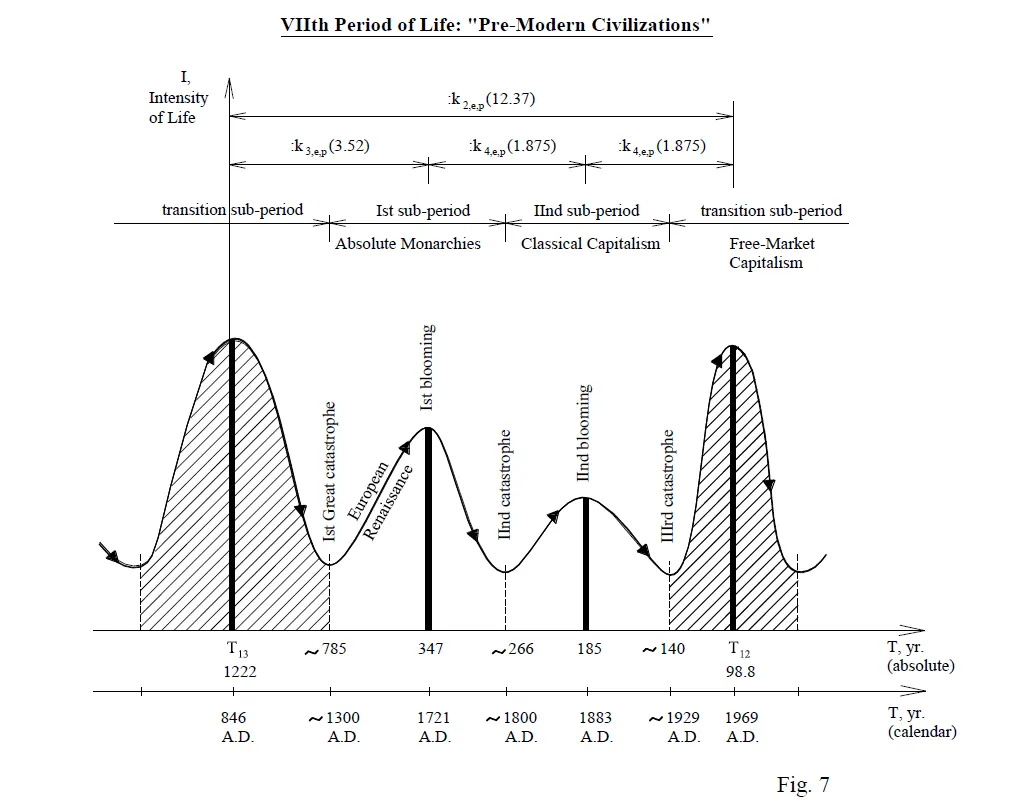
The climb up the curve of Civilized Human Evolution, following the third catastrophe around 300 A.D., saw a renaissance of science not only in Europe but also on other continents. The Mayan civilization developed mathematics and astronomy around 350 A.D. In China, significant advancements occurred, including the invention of the first calculator, paper, and gunpowder around 760 A.D., during the Tang dynasty, known for its achievements in poetry, painting, and medicine. India experienced its golden age of science and culture during the Gupta dynasty (320-500 A.D.).
The Middle Ages, spanning roughly from 846 to 1300 A.D., represent the latter half of the transition sub-period between the fall of the Roman Empire and the onset of the European Renaissance. This era was marked by relative stagnation in science, culture, and technology, with educational and cultural activities being neglected. The Catholic Church played a significant role in shaping this period, with notable architectural achievements such as the construction of great cathedrals.
The first great catastrophe of the Seventh Life Period occurred at the end of the 14th century and the beginning of the 15th century, marked by the “black death” or bubonic plague that decimated the population in Europe and Asia. Wars and invasions further devastated Europe and Asia, including the conquests of Genghis Khan and Tamerlane.
Peasants were the primary productive force during the transition sub-period, working the land and raising cattle as the property of noblemen. Towards the end of this period, craftsmen emerged as another significant productive force, alongside peasants, utilizing improved work devices.
The first sub-period of the Seventh Life Period (approximately 1300 A.D. to 1800 A.D.) witnessed the rise of powerful feudal empires, including the Spanish, Portuguese, Mongolian, English, French, Russian, Inca, Aztec, and Ottoman empires. These were absolute feudal monarchies with centralized power.
The decline of absolute feudal monarchies began with the victories of anti-feudal uprisings in various regions. This period also saw the transition to parliamentary monarchies and republics, with the advent of machine production and the Industrial Revolution around 1715 A.D. Feudal relations were gradually replaced by capitalist systems of production and distribution.
The second sub-period of the Seventh Life Period was dominated by classical capitalism in various countries until around 1929 A.D., marked by the Great Depression and subsequent global catastrophes such as World War I and II, revolutions, and deadly diseases.
The end of World War II, a major social catastrophe, marked the onset of significant global changes in human society. The transition period from 1929 A.D. to about 2010 A.D. is characterized by the emergence of Classical Industrial Society, comprising free-market capitalism and socialist/communist dictatorship republics. This transition sub-period witnessed a remarkable acceleration in the progress of Human Civilization.
During this period, the United States emerged as a leading modern industrial democracy on the world stage.
The period from approximately 1929 to 1968 saw successful anti-colonial revolutions that dismantled old colonial empires such as the British, French, Portuguese, Belgian, and Dutch, among others. This era of ascent on the evolution curve was marked by significant discoveries in physics, chemistry, biology, medicine, and technology. Around 1969, notable achievements in science and technology included advancements in nuclear energy for peaceful applications, the first cosmic flights (such as the Apollo Project), the construction of powerful elementary particle accelerators leading to the discovery of many new elementary particles, the formulation of the Standard Model, advancements in computer technology, and breakthroughs in cosmology such as the Big Bang model and J. Bell’s theorem.
The turning point (dT/dI = 0) on the curve of life evolution occurred around 1978, signaling the gradual destruction of the classic industrial society. This period was associated with the Soviet Union’s unsuccessful invasion of Afghanistan, leading to the start of the disintegration of the Soviet bloc. This disintegration accelerated after the death of Soviet dictator L. Brezhnev in 1982, culminating in anti-communist revolutions in Eastern Europe between 1989 and 1994.
Other significant events during this transition included severe recessions in the USA (1981-1982) and Eastern European former socialist countries around 1996, wars between former Yugoslavian republics, the elimination of the last communist regime in Europe (in Serbia) after NATO’s aerial war against Yugoslavia in 1999, US and NATO wars in Afghanistan and Iraq, “velvet” revolutions in Georgia and Ukraine, the terrorist attacks against the USA on September 11, 2001, and the severe global recession of 2008-2009. Additionally, events like the crisis in Iran in June 2009 were seen as omens of the forthcoming destruction of the Classic Industrial Society.
In his “Centuries,” the great French prophet Nostradamus predicted the advent of this Great First Catastrophe of the Ninth Period of Life.
“In the year 1999, and seven months,
From the sky will come the great King of Terror.
He will bring to life the great King of Mogols.
Before war and after war reigns happily.”
“Evil breeds with haste of vermin.
His cursed brood rules the 200th decade.
The Lamb in battle dress confronts.
The Dark one with his unholy legions
to herald the third millennium.”
The “aerial war” against Yugoslavia in 1999 and the terrorist airplane attack against the USA in 2001 align well with Nostradamus’s prophecy. The Lamb symbolizes the negative aspect of the Classic Industrial Social Order, often associated with the Anti-Christ. The King of Moguls could symbolize figures like Osama Bin Laden, whose stronghold is now located in Kabul, Afghanistan, the historical capital of the Mongol Empire.
Western Civilization, characterized by the Free Market System, is currently in decline. One consequence of this decline is the severe recession being experienced. The manufacturing sector is contracting rapidly, with unemployment rates already reaching 10% in the USA. The partial or full nationalization of major banks and financial institutions indicates forthcoming significant social changes.
The prosperous times experienced by recent U.S. presidents like Ronald Reagan, George Bush Sr., and Bill Clinton are over. The current U.S. president, Barack Obama, faces (and will continue to face) immense challenges. His presidency will coincide with a period of profound transformation. Existing financial and economic institutions will undergo radical reform or be dismantled entirely. The U.S. Constitution may be revised to accommodate the New Social Order, which will see the elimination of the Free Market Social Order. The dominance of Big Capital over ordinary Americans will diminish, and a new energy source, such as Quantum Free Energy, will challenge the monopoly of Big Oil and traditional energy providers. The Modern Civilization will replace the Free Market Social Order.
The days of the Free Market Economy, characterized by exploitation of regular individuals and underdeveloped countries, social and economic injustice, and the dominance of wealthy classes and countries, are numbered. The first catastrophe of the Eighth Period of Life will likely involve a significant event such as a new plague, potentially the Swine Flu, leading to a considerable reduction in the human population. Western Civilization may face threats from the East, including countries like China and certain Islamic nations.
The transition from the Classical Industrial Social Order to the Modern Civilization is expected to occur between 2010 and 2022 A.D. While this transition will be catastrophic for the Free Market Social Order, it will not spell the end of human civilization as a whole. Life will continue in a fundamentally altered form after this event.
There is currently a misguided belief, particularly among conservatives, in the stability and perpetuity of the Free Market Social Order. However, evolution in human society is not solely determined by scientific and technological advancements. It is a quantum chain of social, scientific, and technological events governed by immutable laws of the universe. No amount of wealth, power, extremism, or political conservatism can halt the process of dismantling the current Free Market social order.
The destruction of the Modern Civilization, the last human civilization, will likely occur around 2056 (the third catastrophe) and be completed around 2068 – the End of the World. Isaac Newton predicted 2060 A.D. as the end of the world. Around 2068 (or thereabouts), not only will human civilization come to an end, but also the entire universe. The accelerated destruction of humanity may commence around 2063 A.D., leading to the ultimate demise of the universe in the Indefinite End, often likened to a “black hole.” There will be no celebrations marking the arrival of the year 2100.
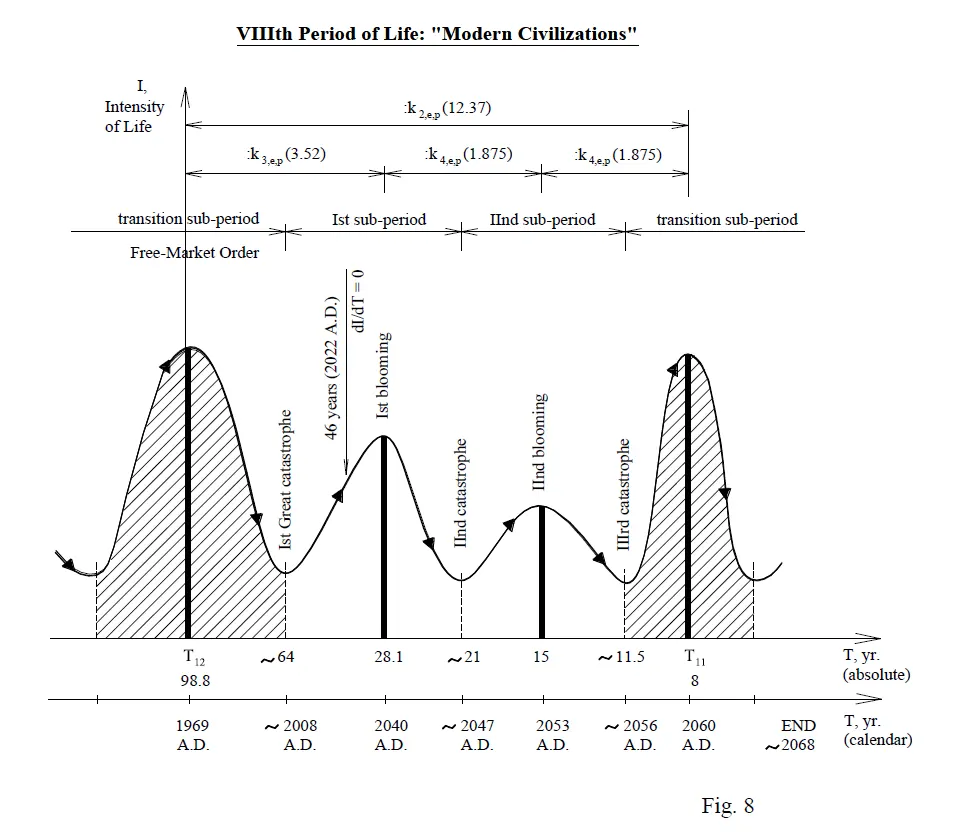
The demographic data about the human population on earth ensures a hyperbolic law:

Където,
C, t0 – constants,
t – time in years A.D.
Based on two reliable milestones on this curve/graph (1000 A.D. – 380 million people; 2000 A.D. – 6 billion people), we have:
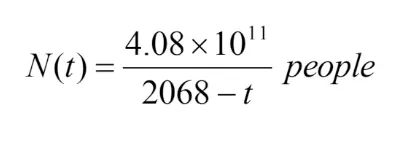
The above formula is not mine; it’s scientists/demographers who deduced it. Year 2068 A.D. is a significant year – the End of the World! This year is beyond reach because the human population cannot become infinite in number! Several years before this ominous milestone year, the human population will begin to decline.
How will this final Armageddon happen? I do not know. Jesus Christ told his disciples: Nobody, not even the Son of God, knows the exact time of the Last Day of the World. Only God knows this day! Perhaps you can find more detailed information about the final days of the world from Saint John’s Revelation (known in some countries as Armageddon). Most likely, some very deadly disease or some other biological catastrophe (such as general sterility of men and women toward the End of the World) will exterminate the last humans on earth.
Scientists warn: A “deadly dozen” diseases (avian flu, tick-borne babesia, cholera, Ebola, parasites, plague, Lyme disease, red tides of algal blooms, Rift Valley fever, sleeping sickness, tuberculosis, and yellow fever) are likely to spread on a large global scale due to climate changes. Darwin’s mechanism of natural evolution of species and the quantum wave of life’s evolution will become very active in favor of bacteria and viruses as the End of The World approaches. The genetic mutation of bacteria and viruses (making them very resistant to antibiotics and other drugs) combined with weakening human immune systems will claim the lives of billions of people.
Natural disasters, whose intensity and amplitude will dramatically increase towards the End of the World, and severe changes in the climate could make planet earth uninhabitable. Cosmic disasters may also contribute to the total extinction of life on earth. One ominous sign (which we are already witnessing today) of the impending End of the World is the rapid decline of mammal species: one in two mammal species on earth are in decline and at least one in four is at high risk of disappearing forever, according to a recent scientific survey.
It is known from biology that for every given species, there exists some critical number of individuals for stable and continuous existence. If the population of a species drops below this critical number, then the species can disappear totally and very quickly. A typical example of total and rapid extinction is the extinction of the North American Passenger Pigeon. Once the most abundant bird in North American forests, in innumerable hordes, this species disappeared at the end of the 19th century (and early 20th), leaving no trace. The human species could disappear in a similar manner.
Like the late Neanderthals, the last generation of human beings may undergo some biological degeneration of their bodies, causing them to lose their social features. Their communities (families, organizations, businesses, towns, countries) may become very unstable and unsustainable for social life.
It’s terrifying to think and write about this. Unfortunately, our children and grandchildren will not have children of their own. We are the last human generations on earth and the last representatives of the Animate Nature!
The present end of the world marks the beginning of the next cycle or circle of the universe. The beginning of life is death, and the beginning of death is life; all part of a great circle-cycle shaped by the Quantum Wave of Life Evolution. This cycle encompasses both good times (climbing up on the curve of evolution) and bad times (climbing down on this curve). Just as there is good and evil in God’s plan of evolution, there is also good and evil in the souls of human beings. Good and evil are two inseparable aspects of the “Human Life” medal.
The current cycle of the world is fundamentally the same as all other cycles, down to the smallest details. There is no other world (parallel universe or paradise) that serves as a refuge for our souls after the physical death of our material body. Everything unfolds here on earth. Here, for the first time in our lives, we see the face of our loving mothers, we grow up, we love, we enjoy life, we marry, we give birth to our children, we see the light of our sun, and we eventually die.
People, do not suffer too much for your beloved deceased relatives, do not lament your bygone happy youth, and do not fear your death and the end of the world. Even though our personal lives are limited in time (about 80-90 years), they are eternal in essence. Within the framework of our quantum time-life, the personal consciousness (the soul) of every human being never starts from zero and never ends at zero. We perceive ourselves only as living human beings, not as biological embryonic cells or as dead human flesh reduced to atoms and molecules. The personal life cycle repeats itself – in the same details – infinitely, without a determined beginning or end. In each life cycle (which is absolutely identical to the others), we encounter our parents, our friends, our children, and the same world around us repeatedly. Between these endless life cycles, there is nothing; there is no time at all, there is no death. The individual life cycles are closed loop quantum time-bubbles within which we are confined forever. We are continuously and eternally located somewhere on the closed “time-line” of our personal quantum “time-cycle”, between the undetermined (only for us) birth and undetermined death. The same principle applies to all quantum cycles of Life, including the Cycle of the Universe/World.
Quantum Wave of Man’s Evolution
A man’s individual life is also influenced by the Quantum Wave of Life Evolution. However, in the case of human evolution, the direction of evolution is inverted. This phenomenon has been explained previously, detailing the underlying cause for this “strange” conversion of time (GQM-III).
The transition sub-period (5.5 – 12 years) corresponds to “childhood”. At around the age of 5-6 years, the last catastrophe of “early childhood” occurs. This marks a qualitative change in the child’s development, as they become a “civilized” human being, attending kindergarten, and learning to read and write. By the age of 8 years, children enter the flowering stage of this transition sub-period, as they begin elementary school. However, the age of 12 is considered dangerous due to puberty, which brings about health and behavioral challenges.
The first sub-period (12-21 years) is commonly referred to as the “teenager age”, characterized by the accumulation of experience and knowledge. This period can be challenging for parents as adolescents navigate their way through various experiences.
The second sub-period represents adulthood. At the onset of the second catastrophe (the beginning of adulthood), individuals typically graduate from high school, equipped with enough knowledge and experience to embark on independent lives separate from their parents. Some may leave their parents’ home, get married, and start working. By the age of 28, individuals reach their flowering stage, having graduated from college, secured good jobs, acquired valuable skills, and often started families. Physically, they have reached their full height, enjoy good health and strength, and are often considered attractive and desirable by the opposite sex.

After experiencing the last flowering in human life, a downfall on the curve of evolution starts. In the zone of the maximum the things are O.K. – people are still healthy, strong enough, still attractive, they accumulated good experience, and they are very productive.
After age 64-65 (approx) – the third catastrophe – serious problems with health start. At this age people are retired. The turning point on the curve of evolution (dI/dT = 0) – about 81-83 years old – is the time when most people die. This age is the average longevity of human life. The number of people surviving this age is small.
The probability of living more than 99 years (the maximum on the curve) is very small.
The turning points on the previous two life periods are: 9 months (women give birth to their babies at the 9th month of pregnancy; and 10 years (?).
In this publication I don’t comment the early human childhood (Figures 10,11).
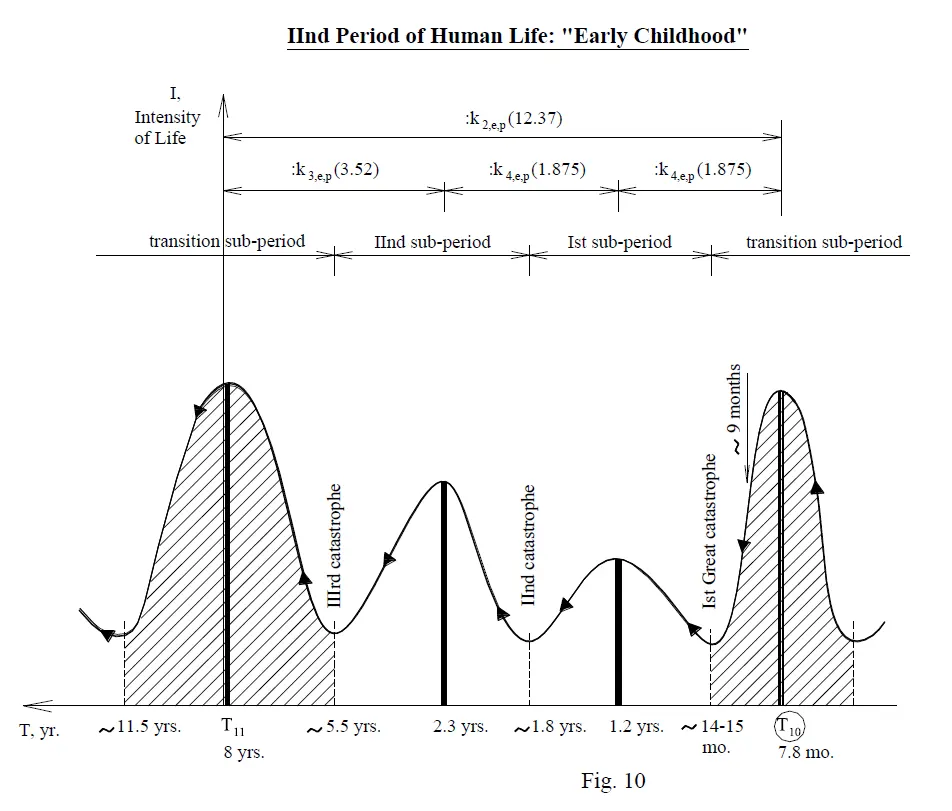
The first (great) catastrophe in the evolution is the most important one: at the zone of this first catastrophe the old (the previous in the evolution) quantum life period (and its corresponding “quantum animate class”) is transformed into new life period and class. For the human being these great catastrophes occur at:
- 28 days (the moon month)
- 1 (one) year
- 11.5 years (the sun’s cycle)
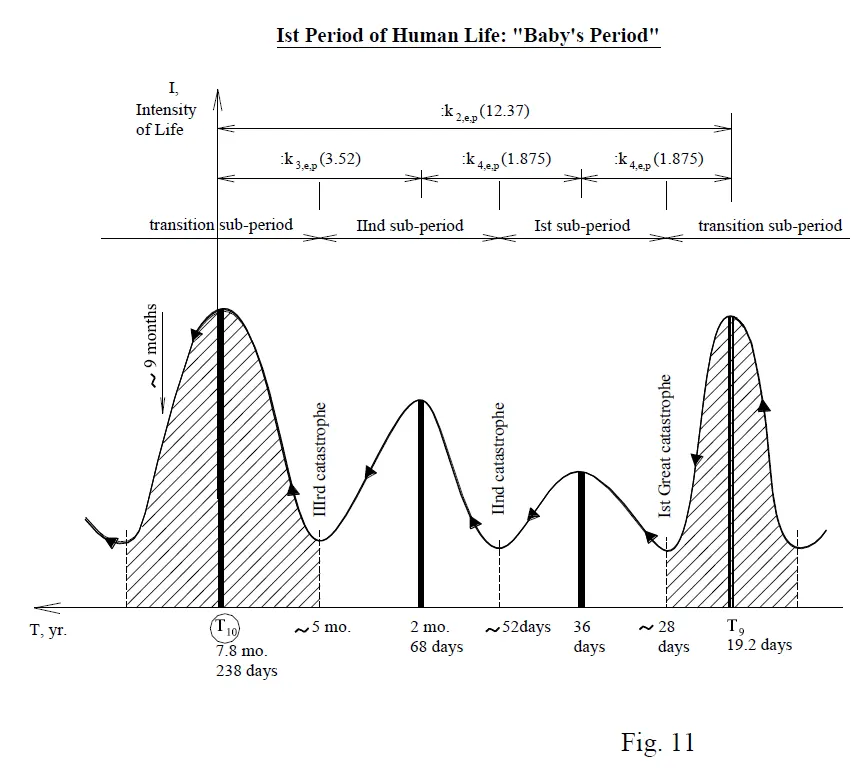
All these quantum time-cycles play an important role in human beings’ biological and social life!
The current calendar is neither natural nor perfect: months comprise varying numbers of days (28, 29, 30, 31), and days of the week (Monday, Tuesday, … and Sunday) occur on different dates, etc. The “moon” calendar appears much more natural and easy to use. I propose the following scheme for a new calendar:
- One year is composed of 13 months, each with 28 days. Every month consists of 4 weeks of seven days each (Monday, Tuesday, …). Each month starts on Monday and finishes on Sunday. Similarly, each year starts on Monday and finishes on Sunday. Each day of the week falls on the same dates: Monday (1, 8, 15, 22), Tuesday (2, 9, 16, 23), etc. This system is easy to remember.
- One year is composed by 52 weeks: 52 x 7 days = 364 days.
- The first day of the year is a leap day, which is not assigned to any specific day of the week such as Monday or Tuesday. This day can be called “New Year Day.” Every four years (Olympic years), we’ll have two “New Year” days. Additionally, people will have two days off at the end of the year (Saturday and Sunday) plus one or two “New Year” days.
- There will be 4 (four) quarters (in the year) each composed by 13 weeks (again this number!).
- и т.н.
Human nature, encompassing the evolution of the body, social life, and behavior, is governed by the Quantum Wave of Life Evolution and other fundamental principles applicable to all material objects in the universe. One such principle is the fundamental unity shared by the individual and the class (the collective quantum image of human beings). The class of all human beings undergoes similar evolution over time, exhibits similar behavior, perceives the environment similarly, and shares common forms and proportions in their bodies. The relations and exchange of bio- and soul-energizers, as well as any other information, between the individual and the class are instantaneous, not limited by the speed of light, and devoid of intermediary material carriers. While each individual varies in particular details, the principles of unity governing the class provide structure, while each individual, with their unique attributes, contributes to the composition within that unity.
It’s imperative for all human beings to recognize that, aside from being individuals, they are manifestations of the “all-human class,” signifying that their souls are individual manifestations of the Holy Spirit (God). Inflicting harm, humiliation, violence, or any form of mistreatment upon another human being is akin to inflicting harm upon oneself, as every human being on Earth is a close relative and a holy counterpart.
Additionally, alongside the “common human class—the human species,” there exist lower quantum levels of human communities such as parents, family, business/organization, city/town, and country. Parents represent the closest quantum level to the individual, and individuals often acquire features, both physical and behavioral, from their parents. It’s observed that individuals born after the death of their fathers may exhibit similar behavioral traits as their deceased fathers, indicating that genes are not solely responsible for the transfer of elements of human behavior from parents or grandparents to their offspring.
It’s evident that no medical advancements or technological devices can enable humans to surpass their quantum limits, let alone achieve immortality. The challenge lies beyond the confines of the human body-in the quantum nature of humans.








